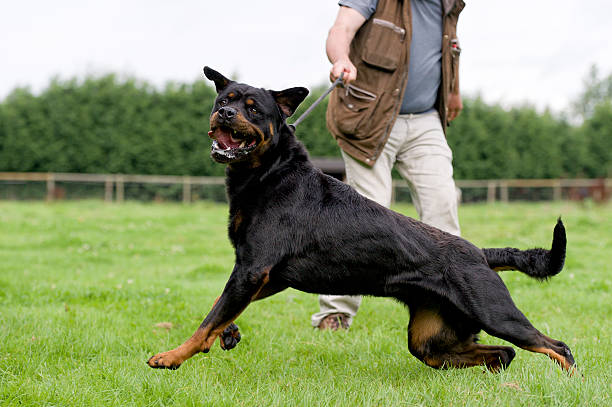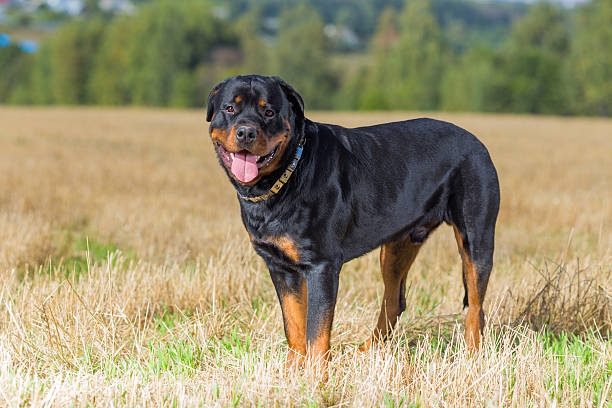Rottweiler

History:
Rottweilers are service dogs that have been a well-known breed in the United States since 1931. They are considered to be one of the oldest surviving furry companions. From Roman times, Rottweilers were kept as driving or herding dogs.
In the area of the Rottweiler, this breed met and mixed with native dogs in a natural crossing. The ancestors of this dog breed were the mastiff-like, cattle-herding dogs of the ancient Romans, who roamed Europe with their armies. While some of these dogs were left behind as the army moved forward, they bred with local sheepdogs in Germany, resulting in the Rottweiler dog breed.
Rottweilers commonly helped herd cattle but also served as property guardians and livestock guardians. In the 1930s, these dogs were first taken to Britain and were authorised by the Kennel Club in the year 1966.
|
Gender |
Height |
Weight |
|
Male |
63-69 cm |
50 kg |
|
Female |
58-64 cm |
38 kg |
Size – Large
Life Expectancy: 8 to 10 years

Breed Appearance:
Also called Rotties, Rottweilers are compact, large dogs. They have a distinctive appearance, characterised by their black coat with clearly visible rust-coloured markings on the chest, legs, and head. These medium-large dogs have a flat-topped snout, triangular ears, and almond-shaped eyes.
Rottweilers usually come in black coats, but their notable markings are particularly seen in three colours – tan, rust, and mahogany. Notably, there are also several types of Rottweilers available, including German, Roman, and American. These variations have different physical structures. Many rottweilers seem to possess a bobtail, rarely a natural occurrence. In most cases, the tail of a bobtailed Rottweiler has been surgically attached.
Breed Type - Family/guard:
Rottweilers are fearless, gentle, and stubborn sometimes. Because of their willingness to please their owner, they are fun to interact with. They are one of the trainable and most intelligent dog breeds out there. Despite the hound-like outline, the Rottweiler is a sensitive companion who demands thoughtful training, handling, and patience.
Note that your doggo friend will make a lovable, capable, fun, and affectionate friend with a lot of games and training. Ideal for pet lovers who stay indoors most of the time to provide love and affection, and who either have sensible children or do not have children at all.
Even though these dogs of this breed have gotten used to the grandeur of urban life, they are still wonderful watchdogs. By having such a breed, you won't have to worry about warlords and thieves.

Training:
Highly intelligent and responsive to training:
-
Ranks among the most trainable working breeds
-
Excels in obedience, tracking, protection, and agility
-
Needs early, consistent socialisation to prevent over-guarding
-
Responds best to positive reinforcement and firm leadership
-
Should not be handled by inexperienced or passive owners
Untrained or under-stimulated Rottweilers can become dominant, destructive, or reactive.
Health & Care:
A generally hardy breed, but some issues to watch for include:
-
Hip and elbow dysplasia
-
Aortic stenosis and other heart conditions
-
Bloat (gastric torsion)
-
Osteosarcoma (bone cancer) in some lines
-
Obesity, if not properly addressed
Regular health screenings, a balanced diet, and controlled exercise in youth are key to longevity and well-being.

Living Conditions:
Adaptable to many home types, with proper care:
-
Can live in apartments if exercised rigorously
-
Thrives in homes with fenced yards
-
Protective and naturally wary of strangers, early training is vital
-
May not do well in homes with many unfamiliar visitors unless well-socialised
-
Good with children and pets, it’s raised with, but supervision is advised
It thrives with confident, involved owners and structured environments
Exercise:
Energetic and muscular, the Rottweiler needs daily physical and mental activity:
-
Requires at least 1.5–2 hours of daily exercise
-
Loves brisk walks, play sessions, obedience drills, and tasks
-
Bored Rottweilers may become destructive or overly territorial
-
Benefits from job-like activities like pulling, scent work, or tracking
Mental stimulation is just as important as physical exertion.
Grooming:
Low-maintenance coat:
-
Brush once or twice a week to remove loose hair
-
Bathe occasionally, or when dirty
-
Check ears and trim nails regularly
-
Maintain dental hygiene for long-term health
-
Sheds moderately, more during spring and fall
Grooming is simple but must be consistent to prevent minor issues.

Advantages:
-
Loyal, protective, and deeply devoted to family
-
Confident and intelligent – excels in obedience and working roles
-
Powerful deterrent – natural guard dog instinct
-
Trainable with strong work ethic – used in police, military, and service work
-
Generally calm and steady-natured with proper training
-
Good with children and pets when socialized early
-
Low-maintenance coat – minimal grooming needs
Disadvantages:
-
Requires consistent, experienced handling and training
-
Can be territorial or reactive without early socialization
-
Not ideal for first-time or passive dog owners
-
Strong-willed and physically powerful – needs firm leadership
-
Prone to health issues like hip dysplasia, heart disease, and cancer
-
Needs daily physical and mental exercise to stay balanced
-
Can be misunderstood or restricted in some housing areas due to reputation







